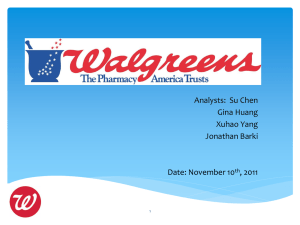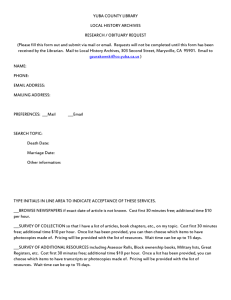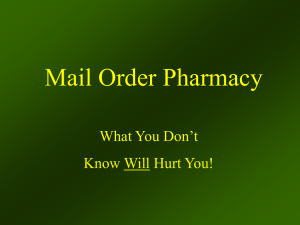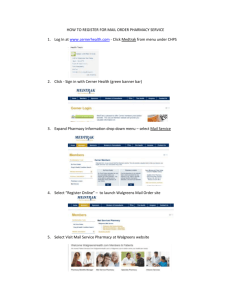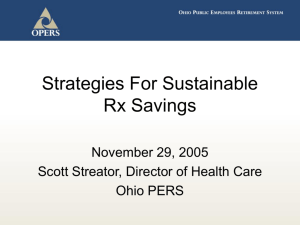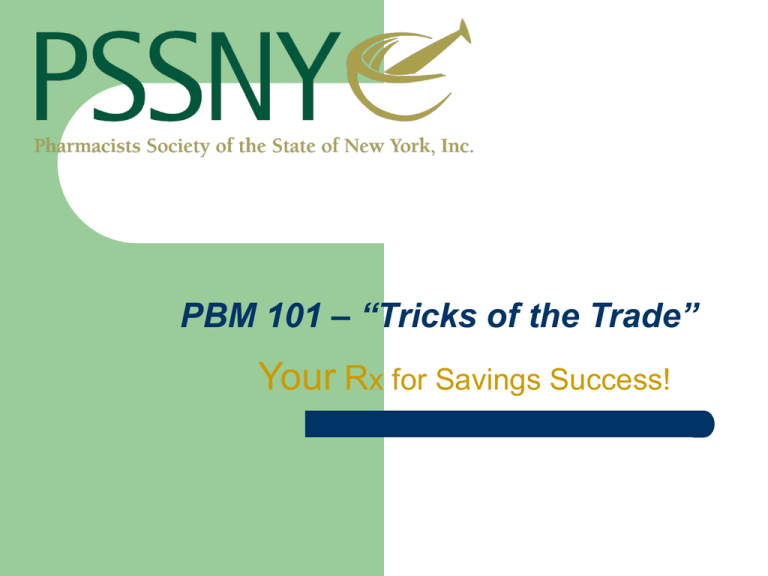
PBM 101 – “Tricks of the Trade”
Your Rx for Savings Success!
Pharmacy Acronyms:
PBM – Pharmacy Benefit Manager: A third party company who
processes prescriptions for health care plan sponsors. PBMs develop
national pharmacy networks and formularies, etc.
AWP – Average Wholesale Price: This is the “published price” of
prescription drugs and is used to determine pharmacy payment for
“branded” drugs. A discounted AWP is typically used to reimburse a
pharmacy on a “brand” drug ingredient cost. (i.e. AWP-15% + $2.00
dispensing fee.
MAC List – Maximum Allowable Cost: This refers to the reimbursement
that a pharmacy receives from a PBM or healthcare insurer for the
ingredient cost of a “generic” drug and typically comes with a
dispensing fee. (i.e. MAC + $1.00)
Reimbursement Spread: - The difference between what the “plan” pays
the PBM and what the PBM pays the pharmacy.
Pharmacy Acronyms:
Brand Drug: This is a single-source innovator drug that still carries a
patent and can not be duplicated by a generic drug.
Generic Drug: This is a “multi-source” drug that was developed from a
former innovator drug whose patent has expired.
Drug Spread: The difference between what the pharmacy pays their
wholesaler for a drug and the AWP published price. This is typically
20% on brand drugs if the pharmacy pays cash and every 15 days.
Generics use an AWP spread system that varies widely. Pharmacies are
not paid on an AWP - % basis for generics. (Reference Pricing) They are
paid from a Maximum Allowable Cost (MAC) list.
Have Pharmacy Benefit Managers
Really Managed Prescription Drug Costs?
► Prescription drug costs have gone up 16%-21% year
after year. Should be flat or declining 2%
► Drug ingredient costs have increased between 7%8% annually with increased utilization of between 1%2%
► Record number of branded drugs have lost their
patents since 2003 with most Innovator drugs losing
their patents by the end of 2014.
Have Pharmacy Benefit Managers
Really Managed Prescription Drug Costs?
► Case Study #1 – Large Labor union (360,000 covered
lives) had a “traditional” (margin-based) PBM pricing
plan.
► Had “mandatory mail order” only Rx plan w/ 2x copays for a 90-day at mail prescription.
► Fund was experiencing 15%-20% annual prescription
drug cost increases.
Have Pharmacy Benefit Managers
Really Managed Prescription Drug Costs?
► Case Study #1 – Union ‘switched’ to a fully
transparent PBM in 2006 and ‘removed’ mandatory
mail order.
► In the First year in the new 90-day at retail
prescription drug program, the union experienced a
more than $45 million savings despite an 8% increase
in drug ingredient cost and a 2% increase in member
utilization.
► It was estimated by the fund’s PBM that they would
save an approximately $210 million over the next
three years.
Have Pharmacy Benefit Managers
Really Managed Prescription Drug Costs?
► Case Study #2 – Mid-sized union (42,000 covered lives)
with active & retirees had a traditional ‘margined-based’
PBM prescription drug program experiencing 19%-20%
annual increases
► Had an incentivised mail order plan (2 x co-pays) with
‘mandatory generics’. Co-pays were 20%-30% of drug
cost
► Had a preferred drug list for all non-generic drugs and
members were limited to $5,000 maximum annual
coverage
Have Pharmacy Benefit Managers
Really Managed Prescription Drug Costs?
► Case Study #2 – In 2005, the Union ‘switched’ to a fully transparent
PBM and entirely removed the mail order option in the first year.
Implemented coverage of certain OTCs with no co-pays
► In first year, prescription drug costs remained flat despite an 8%
increase in drug ingredient cost
► Fund was able to enrich the member benefits with:
●
●
●
●
Lowered co-pays from 20% & 30% of drug cost to $10 or $20
Increase annual coverage from $5,000 to $7,500
Added a “Full Dental” benefit
Saved $700,000 in year one
How do PBMs make money?
Are they really looking out for
you?
3 Ways the make money on YOU:
► Spreads on generic drugs. MAC vs. Reference Pricing
vs. Pass-through Billing
► Calling Drug Manufacturer Rebates Something Else
► Varying AWPs through: payment formulas, ‘repacker’
NDC #s or package sizes manipulations
How do PBMs make money?
Are they really looking out for
you?
Reference Pricing vs. MAC:
Reference Pricing refers to the AWP-% that YOU pay
Maximum Allowable Cost (MAC) is how the PBM PAYS
retail pharmacies.
The TWO are NOT the SAME
Pass-through Pricing: YOUR Best Bet!
Price Spreads on
Generic Drugs:
Upstate NY School
District – “Reference Pricing vs. MAC Pricing”
Mail Order “Reference Pricing”
(Generic for Flomax©)
Retail “Maximum Allowable Cost”
(Generic for Flomax©)
Tamsulosin CAP 0.4 MG
Tamsulosin CAP 0.4 MG
90 Count = $283.58 pd.
Co-pay = $16.00
90 Count = $9.02 pd.
Co-pay = $20.00
Mail Order “Reference Pricing”
(Generic for Zocor©)
Retail “Maximum Allowable Cost”
(Generic for Zocor©)
Simvastatin TAB 20 MG
Simvastatin TAB 20 MG
90 Count = $333.81 pd.
Co-pay = $16.00
90 Count = $0.00 pd.
Co-pay = $20.00
Price Spreads on
Generic Drugs: Upstate NY School
District - “Reference Pricing vs. MAC Pricing”
Mail Order “Reference Pricing”
(Generic for Paxil©)
Retail “Maximum Allowable Cost”
(Generic for Paxil©)
Paroxetine TAB 30 MG
Paroxetine TAB 30 MG
90 Count = $184.10 pd.
Co-pay = $16.00
90 Count = $6.95 pd.
Co-pay = $20.00
Mail Order “Reference Pricing”
(Generic for Norvasc©)
Retail “Maximum Allowable Cost”
(Generic for Norvasc©)
Amlodipine TAB 5 MG
Amlodipine TAB 5 MG
90 Count = $106.96 pd.
Co-pay = $16.00
90 Count = $0.00 pd.
Co-pay = $20.00
Price Spreads on
Generic Drugs: Upstate NY School
District - “Reference Pricing vs. MAC Pricing”
Mail Order “Reference Pricing”
(Generic for Pravachol©)
Retail “Maximum Allowable Cost”
(Generic for Pravachol©)
Pravastatin TAB 20 MG
Pravastatin TAB 20 MG
90 Count = $216.29 pd.
Co-pay = $16.00
90 Count = $5.96 pd.
Co-pay = $20.00
Mail Order “Reference Pricing”
(Generic for Amaryl©)
Retail “Maximum Allowable Cost”
(Generic for Amaryl©)
Glimepiride TAB 4 MG
Glimepiride TAB 4 MG
90 Count = $71.43 pd.
Co-pay = $16.00
90 Count = $0.00 pd.
Co-pay = $20.00
Price Spreads on
Generic Drugs: Upstate Small
Business - “Reference Pricing vs. MAC Pricing”
Mail Order “Reference Pricing”
Omeprazole
90 Count = $221.00 pd.
Retail “Maximum Allowable Cost”
Omeprazole
90 Count = $123.00 pd.
Mail Order “Reference Pricing”
Simvastatin (different PBM)
90 Count = $63.00 pd.
Retail “Maximum Allowable Cost”
Simvastatin
90 Count = $33.00 pd.
Price Spreads on
Generic Drugs: Upstate Small
Business - “Reference Pricing vs. MAC Pricing”
Mail Order “Reference Pricing”
Metoprolol Succinate
90 Count = $97.00 pd.
Retail “Maximum Allowable Cost”
Metoprolol Succinate
90 Count = $81.00 pd.
Mail Order “Reference Pricing”
Sertraline Hcl
90 Count = $87.00 pd.
Retail “Maximum Allowable Cost”
Sertraline Hcl
90 Count = $42.00 pd.
Price Spreads on
Generic Drugs: “Reference Pricing
vs. MAC Pricing vs. Pass-through Pricing”
Pass-through Pricing: REQUIRES the PBM to charge the plan
sponsor only that amount they paid the retail pharmacy or the
mail order pharmacy including any dispensing fees
Pass-through Pricing guarantees the plan sponsor WILL NOT
pay any “Hidden Spreads” on generics or branded drugs
Pass-through Pricing vs. MAC: PBMs can manipulate MAC
pricing and include “spreads” for themselves
If you use Pass-through Pricing, you will have to pay either a
“per-prescription” or “per member, per month” administrative fee
Administrative fees are ‘Transparent’ and make PBMs compete
for your business based on ‘known’ costs.
Price Spreads on
Generic Drugs: “Reference Pricing
vs. Pass-through Pricing” – THIS is a BIG DEAL!
A sample of generic drug prescriptions charged to
payer by Medco Health. Note gross profit of $42.29
per prescription!
The same prescriptions using a pass-through,
transparent pricing model: gross profit = $7.08 per
prescription.
Why ‘Spreads’ on Generics?????
2003-2005 – Record number of Brands losing their
patents in the history of the prescription drug
industry.
By 2016 – Remaining Innovator brands will be losing
their patents.
PBMs will be losing hundreds of millions of dollars in
annually “kept” drug manufacturer rebates.
Generic Industry Players
(Market Share of Total Generic Prescriptions)
Generic Company
Market Share
Teva
20.8%
Mylan
9.8%
Sandoz
8.3%
Watson
6.0%
Apotex
3.0%
Hospira
2.9%
Greenstone (Pfizer)
2.5%
Boehringer Ingelheim
2.5%
Par
2.3%
Wyeth
2.3%
Mallinckrodt
2.2%
KV
2.0%
Cobalt
1.9%
Actavis
1.9%
Fresenius Kabi
1.9%
Dr. Reddy
1.8%
Baxter
1.3%
Ranbaxy
1.3%
Glenmark
1.2%
Market Share Less than 1.2%
APP Pharmaceuticals
Ben Venue Laboratories
Caraco
Coastal Pharmaceuticals
Ethex Corporation
Fougera
Glades Pharmaceuticals
Great Southern
Laboratories
Harris Pharmaceutical
Hi-Tech Pharmacal
Impax Laboratories
Laboratorios Silanes
Paddock Laboratories
Pegasus Laboratories
Tolmar
River's Edge
Pharmaceuticals
Sovereign
Synthon
Taro Pharmaceuticals
Three Rivers
West-Ward
Zydus Pharmaceuticals
GeneraMedix
Amneal
Rhodes
Heritage
Bioniche Pharma Group
Eagle Pharmaceuticals
Novel Laboratories
Spear Pharmaceuticals
Sagent Pharmaceuticals
Kremers-Urban
VersaPharm.
Momenta
Amerigen
Strides
Merro Pharmaceutical
21
Generic Competition Dramatically Reduces Drug Prices
100%
Average Relative Price per Dose
90%
Average Relative Price (avg generic / brand)
80%
70%
60%
52%
50%
44%
39%
40%
33%
26%
26%
30%
23%
20%
22%
21%
20%
24%
20%
15%
13%
10%
11%
9%
8%
6%
16
17
18
19
0%
2
3
4
5
6
7
8
9
10
11
12
13
Number of Generic Manufacturers
Source: FDA analysis of retail sales data f rom IMS Health, IMS National Sales
Perspective (TM), 1999-2004, extracted February 2005
14
15
Brand & Generic Prices for a Typical Drug
$300
Price for 100 Tablet Prescription
$250
$200
Generic Entry
$150
$100
By six months following the launch of
generics, generic manufacturers typically
capture 90% of the drug's volume
Additional generic manufacturers
launch products over time and
drive prices to very low levels
$50
$0
1
2
3
4
5
6
7
8
9 10 11 12 13 14 15 16 17 18 19 20 21 22 23 24 25 26 27 28 29 30 31 32 33 34 35 36
Month
Brand Price
Generic Price
23
Medicaid Brand vs. Generic - 2010
Generics are 69% of Prescriptions Dispensed
31%
186 Generic Million
69%
Only 18% of all
Medicaid drug spending
18% Generic
82% Brand
Medicaid Brand Rx costs 10x more than Generic Rx
$250
$200
$201
$150
$100
$50
$20
$0
Avg. Brand Rx
Avg. Generic RX
Source: Medicaid State Drug utilization Data.
25
Generic Drugs: Is there more savings there?
For every 1% increase in your plan’s generic drug use, you
SAVE 2.5%
Retail pharmacies dispense generic drugs more often by 1013% points higher than do mail order pharmacies owned by the
BIG Three PBMs
A health plan with just 10,000 beneficiaries, for every 1%
increase in generic use, the plan can save $180,000
Based on this finding, the 10-13% higher generic utilization by
retail pharmacies can potentially save the 10,000 member
beneficiary plan between $1.8M to $2.34M annually
A study found that plans promoting mail order pharmacy with
co-pay incentives PAID 21.4% to 25% more for generic drugs
Mail Order Pharmacy: There exists a widespread
perception that mail order is cheaper- Why?
Because PBM’s control your drug costs either directly through
terms of your contracts with them or indirectly through your
insurer’s contract.
A surprising number of PBM contracts lack drug definition
clarity or any definitions at all, allowing PBMs to manipulate
drug classifications.
PBMs can overcharge clients on generics by classifying them
as brands or classify some brands as generics to lower rebate
expectations. (Linda J. Cahn, J.D.; Managed Care, Nov., 2010; pp. 21-27)
Additionally, PBMs can bill you using ‘reference pricing’ for
certain high volume generics but pay pharmacies using a MAC.
Mail Order Pharmacy: There exists a widespread
perception that mail order is cheaper- Why?
PBM’s may insist that mail order only contracts allow them
negotiate deeper discounts from drug manufacturers based on
volume
Discounts are based on the ‘Number of Lives Covered’ and
‘Market Share Movement’ (brands-formulary) so, it doesn’t
matter whether you get a prescription filled at retail or mail order
But, “we saved thousands when we went to mandatory mail
order.” Compared to What?
Did you KNOW what retail pharmacy was paid BEFORE you
moved to mandatory mail order? Or, just what your PBM was
BILLING you?
Specialty & Mail Order Drugs: The
Myth of Savings……
PBM’s impact on so-called “Specialty Drugs”
–
Buying up specialty drug pharmacies making plans think
that the PBMs are the only ones that can provide these
services - Myth
–
PBMs getting “exclusive” contracts with specialty drug
manufacturer’s which has increased prices exponentially Fact
–
i.e. One PBM got the exclusive distribution contract on a
children’s epilepsy drug (H.P. Acthar Gel) and increased the
price from $1,600 per tube to $23,000 per tube or 1400%!
(See AAI report) - Fact
–
NYC’s PICA (specialty drug mail order program) costs
skyrocketed in the first year. Hundreds of millions in
overcharges found in audit and the program split up - Fact
Specialty & Mail Order Drugs: The
Myth of Savings…..
Mail Order of Specialty Drugs Can Lead to
Significant Cost Overcharges and Waste
–
Very expensive specialty drug coming through mail order
pharmacies have been ‘over-dispensed’ - Fact
–
Mail order waste of ‘specialty drugs’ cost payers millions
when a PBM continues to ship these medications even
when notified that the individual patient was deceased Fact
–
Wasted drugs continues to cost payers when Mail Order
pharmacies ship medications no longer used, discontinued
or provide 90-day supplies to now former employees - Fact
Waste in Specialty Pharmacy - Nutropin
This patient receives 16 months of medication therapy in 12 months.
Medication cost of therapy: $3,600 per month x 4 months equals $14,400
in wasted dollars each year. (20 boxes = $72,000) Therapy will end in four
years leaving 32 boxes unused or $115,200 in wasted drug cost for just
ONE patient.
The COST of WASTE
In the two DEA-sponsored “Drug Take Back”
days held in October 2010 & April 2011
–
–
–
A TOTAL of 620,000 lbs. of drugs were collected
and burned.
620,000 lbs. of drugs = 248 million pills
Cost to the health care system: $660 million
Who Regulates PBMs?
In the Federal or New York State Governments?
Publicly traded PBMs are regulated by the Securities and Exchange
Commission.
–
Protects their investors not consumers or plan sponsors
PBMs cannot point to a single line of NYS state code that regulates how
they conduct their business despite the fact that PBMs:
control what drugs millions consumers can and cannot have covered by
their plan – called ‘formulary management’
switch drugs for corporate gain – (Nexium vs. Prilosec OTC)
determine where consumers can get their prescriptions filled, and
removed themselves from any fiduciary responsibility to their clients.
PBM’s: “We have Everything Under
Control. Trust Us”
Manufacturer’s Rebates:
What’s Yours is Mine
Are you getting 100% of the 80% of drug
manufacturer rebates your PBM promised? Or,
Are you only getting 100% of 50% of what you were
promised?
PBMs often call rebates something else and keep
the rest for themselves
–
Administrative fees;
Data collection fees;
Formulary Management fees;
Education grants
–
Research fees
–
–
–
Manufacturer’s Rebates:
What’s Yours is Mine
Prescription Drug Plans should insist on 100% “Pass-through”
of ALL drug manufacturer’s rebates
You must insist on being able to ‘audit’ both your ‘pass-through
drug pricing’ and ‘rebates’
Your best friend could be your local independent pharmacist.
They can tell you ‘what’ they got paid for the drugs (top 50 most
dispensed generics)
Your contract MUST insist on Transparency for all costs including
Prior Authorization’s (which should be part of the bidding process)
Repacker Average Wholesale Prices:
A Slight of Hand Can Cost You BIG!
What is A Repacker Number?
It’s typically a branded drug (can be generics) granted a new
NDC number by the FDA to reflect a package size that may be
different than the original manufacturer’s common package sizes
Repackers determine what their Average Wholesale Price (AWP)
will be on that New NDC number, not the original manufacturer
What you get are AWP’s that are often higher and even much
higher than the original manufacturer’s published AWPs
Therefore, your discount of AWP-20% may be MUCH HIGHER
than original manufacturer’s published AWP-18%
Example:
National Drug Code (NDC) Number
Eleven digit number that defines manufacturer, type of
drug and package size.
This number may be printed on reports without hyphens.
AWP (Average Wholesale Price) is specific for each
NDC number.
12345
Manufacturer
–
6543
Drug
–
21
Package Size
Repacker Examples:
Original Manufacturer’s AWP (Pfizer) as listed in the 2010 Red Book
$ Celebrex 200MG – NDC#00025-1525-31- 100’s
AWP - $4.43 per capsule
Repackers AWP’s as listed in the 2010 Red Book
$ Celebrex 200MG – NDC#66105-0106-10- 100’s
AWP - $8.35 per capsule
$ Celebrex 200MG – NDC#68387-0552-30- 30’s
AWP - $8.60 per capsule
$ Celebrex 200MG – NDC#49999-0004-00- 100’s
AWP = $9.31 per capsule
Example:
Package Size Differential
Are YOU being Billed using only 9 NDC digits?
Pharmacy Paid on
Client Charged on
1000’s Size
100’s Size
AWP – 14% + $2.00 =
AWP=$100.00 - $14.00 + $2.00 =
$88.00
AWP – 12% + $2.50 =
AWP=$105.00 - $12.60 + $2.50 =
$94.90
$94.90 – $88.00 =
$ 6.90 PBM profit add-on
Protecting your bottom line requires ongoing vigilance.
Champion Transparency!
Transparency will:
■ Keep you aware of the changing drug marketplace
issues affecting your budgets.
■ Alert you to what you are really paying for
prescription drugs.
■ Promote your commitment to your members or
employees by keeping their out-of-pocket costs
down.
210 Washington Avenue Extension, Albany, NY 12203
800-632-8822 ∙ 518-869-6595 ∙ Fax: 518-464-0618
Web: www.pssny.org ∙ Email: staff@pssny.org
Copyright © 2009 by PSSNY.
All Rights Reserved.

